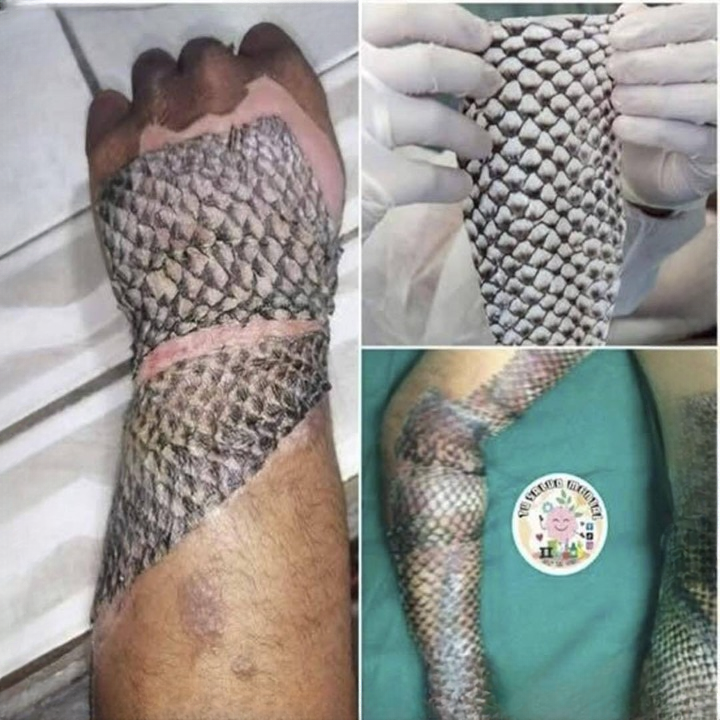Tilapia Skin: How a Simple Fish Is Transforming Modern Burn Treatment
Medical breakthroughs don’t always come from high-tech laboratories or million-dollar equipment. Sometimes, life-saving innovations are born from the most unexpected sources — from nature itself, in the everyday things we often overlook. One of the most astonishing examples is the use of tilapia skin in treating burn injuries — a discovery that has captivated the medical world for its effectiveness, affordability, and remarkable healing results.
A Natural Alternative to Conventional Treatments
For decades, burn care relied on expensive creams, skin grafts, and synthetic materials designed to protect damaged tissue and prevent infection. But in Brazil, researchers stumbled upon a natural alternative that was not only cheaper but surprisingly effective: the skin of the tilapia fish.
Tilapia, one of the most widely consumed fish in Latin America, produces tons of discarded skin every year. What was once considered waste turned out to have extraordinary healing potential, capable of revolutionizing wound care.
From Discovery to Medical Revolution
It began in northeastern Brazil, where scientists sought a low-cost treatment for burn patients in overcrowded public hospitals. They discovered that tilapia skin is rich in collagen types I and III — proteins essential for human tissue regeneration. Its firm, elastic texture is biologically similar to human skin, making it a perfect temporary graft.
Laboratory and clinical tests yielded astonishing results. Tilapia skin adheres well to wounds, creates a moist protective barrier, accelerates healing, reduces pain, and minimizes infection — becoming, quite literally, a “second skin.” Patients reported almost immediate relief, and studies confirmed faster healing and reduced scarring compared with traditional methods.
How the Process Works
Before use, tilapia skin undergoes thorough sterilization and preservation. It is carefully cleaned, disinfected, and treated with glycerol to ensure safety. In hospitals, doctors place it directly over burn wounds, often leaving it in place for several days, reducing the need for constant dressing changes — a relief for patients and medical staff alike.
The benefits are significant: faster recovery, less scarring, lower infection risk, and dramatically reduced costs. This process turns a plentiful, inexpensive byproduct into a life-saving resource, merging sustainability with compassion.
Healing the Body — and the Spirit
Beyond science, this innovation carries a deeply human message. Burn survivors, facing months of painful recovery, can experience relief and hope from a simple, natural treatment. Many describe it as “a second chance at life,” restoring not only their physical health but also dignity and optimism.
Beyond Burns: Future Possibilities
Encouraged by success, researchers are exploring new uses for tilapia skin — from diabetic ulcers to post-surgical wounds. Early trials show promise, suggesting this technique could play a major role in regenerative medicine worldwide. Safety tests confirm that tilapia skin is biocompatible, accepted by the human body, and causes minimal pain when removed.
Global Interest and Widespread Impact
As news spread, hospitals and universities in Latin America, Africa, and Asia began exploring how to adopt the technique. Its appeal is clear: affordable, sustainable, and easy to produce. What began as a local experiment has become a model for accessible healthcare innovation, built on years of rigorous research and ethical oversight.
A Lesson in Sustainable Medicine
Tilapia skin represents the future of healthcare — inclusive, sustainable, and respectful of nature. Instead of relying solely on synthetic materials or costly procedures, medicine can draw from natural resources to create effective treatments. What was once discarded has become a life-saving tool, a symbol of curiosity, compassion, and ingenuity.
Conclusion
Tilapia skin is more than a medical curiosity — it is a quiet revolution in burn treatment. Combining nature’s wisdom with human innovation, it offers an ethical, effective, and sustainable path forward. Sometimes, the smallest creatures — and the simplest ideas — spark the greatest transformations.
